Maurice is the overall winner of the UK Butterflies 2006 Photography Competition. His winning entry of a pair of Marsh Fritillary is shown below.
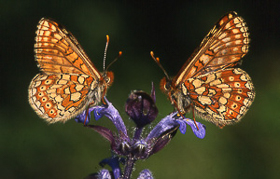 |
| Marsh Fritillary Image © Maurice Pugh |
Natural history is something that I have had a passion for ever since an early age, and I am getting a "bit long in the tooth" now. My favourite subjects are butterflies, moths, orchids, dragonflies and fungi, but I will photograph anything in nature.
Photography is another passion, especially taking macro images - getting those shots that most people would not see and not know what they are missing. Most macro shots show fine detail that cannot be seen by the casual observer. The shots I take are for my pleasure and enjoyment, to illustrate my Natural History talks and to share them with others. I don't go out to get a winning picture, but if one comes along I am even happier.
My Way, the one that works for me, has only one rule ...
If it works for you and you get enjoyment and excitement with the taking, viewing and showing of your work then you must be doing something right! Any rule is there to be broken as I know, since I break them myself a lot of the time.
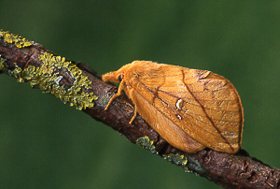 |
| Drinker moth Image © Maurice Pugh |
A little bit of background ...
I am a slide film user, Fuji Sensia being my preferred choice. I have nothing against "digital" (I am thinking very seriously about going down that road in the near future). Looking at the photos entered in the UK Butterflies photography competition, I would hazard a guess that many were digital capture.
My equipment at the moment is an SLR (single lens reflex) body with 100mm and 180mm macro lenses (for close-ups), a 24mm wide angle lens (for habitat shots) and a 300mm lens and 25mm extension tubes (to allow close-ups with a greater working distance). I use a Benbo Mk1 tripod (the heavy one) 99% of the time (sorry, I exaggerate, 95%) - even for butterfly/dragonfly shots out in the field. With it I can use slower shutter speeds, which in turn gives greater depth of field (by allowing the use of smaller apertures). I also use a tripod which gives me sharper pictures (since there is less camera shake). It can also give me time for more careful framing.
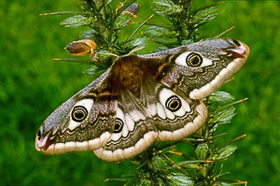 |
| Emperor Moth Image © Maurice Pugh |
I live on the edge of the New Forest in Hampshire and get a lot of my shots locally. My one bit of advice to any new photographers would be to get to know your own patch and know it well. You don't have to jet off to foreign climes to get the best nature shots, although I'm told it is possible. The more times you get out with the camera, the more shots you will get. Make your own luck.
My method for butterflies and other flighty subjects is to find them at rest and then to look for the best angle that will give me a diffused background, usually from a low position. Not all of my shots are taken in this style - I vary the shooting distance and get the background in shot to give some idea of the habitat. Also try getting shots of butterflies on leaves, flowers, seed heads, grasses, tree trunks and of course try for mating pairs. I like to get the wings of the subject parallel with the plane of the film as this will give more of the subject in sharp focus. Then get closer without disturbing the subject - this can be described as 'stalking' and after practice will come as second nature.
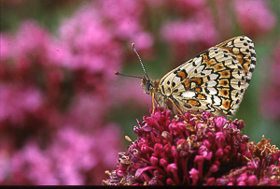 |
| Glanville Fritillary Image © Maurice Pugh |
If you have the choice between a butterfly that is in pristine condition or one that is tatty, then the one in good condition will make a better picture. Anyone looking at, or judging, a picture will always choose the one where the butterfly is in the better condition. Bits missing from wings and faded colours lower the quality of the final shot.
I feel that composition makes a good photograph. When I am composing the shot I look around the edges of the viewfinder to see if there are any distracting highlights. These can be caused by the sun shining on leaves, grass or even on the subject. Light-coloured flowers (daises for example) can be a problem if they intrude into the shot. I find that grass stems, although thrown out of focus, can sometimes show up as a light band across the picture. Going to the other extreme, if all the background is in focus, the picture can be over fussy with grass, twigs or even parts of buildings encroaching into the shot.
With a single butterfly I would rather take the shot with the subject at an angle across the diagonal of the frame rather than square on in the frame. All that is required is to tilt the camera a little to the left or to the right. This moves the shot on from what I consider to be a front-on 'mug' shot and makes it more dynamic. When butterflies are sat on a grass stem or seed head then, again, putting it on a diagonal helps, rather than have it straight up and down across the centre of the picture. I like to have a little more space in front of the head of the butterfly instead of the head being right up against the edge of the picture frame.
On my SLR I have the use of a depth of field preview button with which I can check out what is, and what is not, in focus and if there are any distractions. This I find to be of great help.
Getting in closer, without disturbing the butterfly, so that the subject is not too small in the frame, will let the viewer see what the subject is. In some pictures it is difficult to see the main subject because of its small size. (A friend took a shot of a Small Tortoiseshell, so small in the frame, that now we always make a joke about the "small" Tortoiseshell). Don't get in too close and clip off the wing tips of the butterfly - get the whole of the subject within the frame.
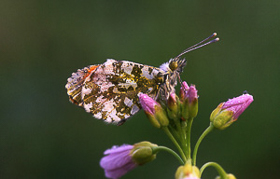 |
| Orange-tip in Dew Image © Maurice Pugh |
Lighting also plays a big part in the scheme of things. I would prefer a day with overcast conditions. Bright sunny days make for contrasty shots with too many highlights. In hot sunny weather butterflies are on the move all the time, their only thoughts are of food and sex, so it is more difficult to get your shots. I hate it when they hardly ever settle. A good time to go out is in the early morning before butterflies and other insects take wing. Evenings work just as well as some butterflies roost close to the ground and become very approachable. I don't use flash as I prefer using natural light. Flash, if not done correctly, can give artificial results, such as a black background as if the shot was taken at night. And as we know, not many butterflies fly during the hours of darkness. "Fill-in flash", balancing flash with ambient light, if done correctly, produces a very good shot, but needs experimenting with and a little practice.
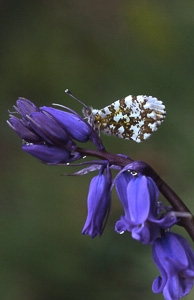 |
| Orange-tip on Bluebell Image © Maurice Pugh |
Getting the exposure right is usually left to the meter within the camera, but it can be fooled with dark or light subjects. If you are not happy with the shots you are taking, if they are too bright (over exposed) or too dark (under exposed) then try bracketing (taking shots at exposures either side of the meter reading) and seeing which gives the correct exposure. With digital capture exposure mistakes can be rectified in the computer.
Choosing the correct shutter speed, will eliminate camera shake and 'freeze' movement in the subject. Too slow a shutter speed and blurred images will result and these will be destined for the bin.
The above conditions rarely all come together but when they do it's time to 'fill your boots'. I'm not trying to make it out to be difficult or impossible - many photographers do get lots of shots when it is just a matter of getting in and pressing the button with no planning being necessary.
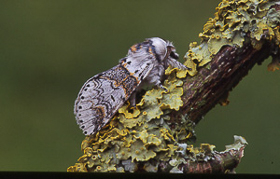 |
| Sallow Kitten Moth Image © Maurice Pugh |
Fungi and flowers are easier to shoot as they don't fly away, but flowers move in the slightest of breezes and patience is called for. I use small reflectors whenever possible to put light back into areas that are shaded e.g. the underside of fungi to put light onto the gills and the stipe (stem).
One of the most important pieces of equipment when out shooting fungi is a bin liner to kneel on, saving wet and dirty knees. This isn't strictly advice on butterfly photography but I have used reflectors on several occasions when I have found them roosting in the early evening and needed that little bit more light on the subject.
It doesn't matter how careful I am, there are many times when I do get things wrong. When I get the slides back from the processors I see distractions in the shot that I had missed at the time of taking. And then there are times when I wish I had hit the button earlier since I have missed the shot. So it is back to the drawing board and another day out taking more photos ... life is hard! Then there are the times when the butterflies haven't read the script and do their best to thwart me by continually moving round flower heads before I can get a shot in.
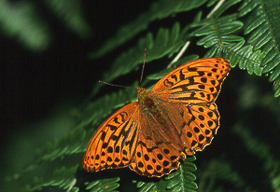 |
| Silver-washed Fritillary Image © Maurice Pugh |
When you review your images be critical - don't keep them all - bin those that are not up to standard. I will discard a number of my shots when I get my slides back from the processors. Try to learn from your mistakes. Looking at the high standard of photography in the images in the UK Butterflies competition then I would say that there are a lot of very skilful photographers out there taking very good shots. A shot that is a little different in some way will do better than the standard record shot. To stand a better chance at winning that next competition, get the shot that stands out from the rest.
If your picture has that "wow" factor it will stand a better chance than the standard record shot. I was disappointed that there were few pictures of mating pairs of butterflies as this kind of shot can be a winner. These shots can be used in "behaviour" sections as well as in the main butterfly category.
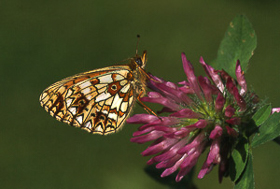 |
| Small Pearl-bordered Fritillary on Clover Image © Maurice Pugh |
Now to move on to the winning shot in the UK Butterflies butterfly competition (the Marsh Fritillary shot shown above) and how it was taken (about time I hear you say!!!). I went out early one morning to a local nature reserve to try for shots of Pearl-bordered Fritillary. Marsh Fritillary were on the reserve in very small numbers so I wasn't really expecting to see them. After a while on the reserve, and without seeing any Pearl-bordered Fritillary, the sight of the two Marsh Fritillary on the bugle flower head stopped me in my tracks. I must admit that my heart started to pound as I recognised that there was a great shot there if only I could get in close enough. So quickly choosing the 300mm lens and 25mm extension tube, with the tripod set as low as it would go, I started to crawl on my hands and knees, pushing the tripod in front of me, getting closer to the subject. I shot a couple of pictures to "get it in the bag" but knew I had to get in closer. So with heart pounding and with the subject filling the frame I hit the button. Bingo. The rest is history. I had got what has turned out to be my favourite butterfly shot, ever.
Within what seemed ages, but was probably only a very short time, one of the butterflies flew off. I managed a couple of shots, still in the landscape format, of the remaining butterfly and then another couple in the portrait format before it flew off as well.
I hope that this has been helpful, and that I haven't been telling you "how to suck eggs". Get to know your camera and your subjects. Learn the basics, it's not rocket science. I have been a member of Southampton Camera Club for several years and find that the competition between members to get good shots, whether in nature or other subjects, has helped to improve my standard of photography. There are always lots of friendly people within Camera Clubs, with plenty of experience and they are only too willing to pass on their knowledge.
Why not join Butterfly Conservation? They do such a lot of good work for our butterflies. The county branches also organise visits throughout the season to the best butterfly sites with lots of opportunities to see many butterfly species, indulge in photography and also meet with like-minded people.
I hope that this article will help you to improve your photography, to get that better shot and win that next competition! I look forward to discussion on the UK Butterflies forums of any or all points covered or those that you feel I have omitted. There is lots of technical stuff but I will not bore you with it at this stage.
One final bit of advice ...